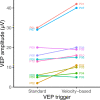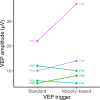Eyetracking-enhanced VEP for nystagmus
- PMID: 38129574
- PMCID: PMC10739974
- DOI: 10.1038/s41598-023-50367-y
Eyetracking-enhanced VEP for nystagmus
Abstract
Visual evoked potentials (VEPs) are an important prognostic indicator of visual ability in patients with nystagmus. However, VEP testing requires stable fixation, which is impossible with nystagmus. Fixation instability reduces VEP amplitude, and VEP reliability is therefore low in this important patient group. We investigated whether VEP amplitude can be increased using an eye tracker by triggering acquisition only during slow periods of the waveform. Data were collected from 10 individuals with early-onset nystagmus. VEP was obtained under continuous (standard) acquisition, or triggered during periods of low eye velocity, as detected by an eye tracker. VEP amplitude was compared using Bonferroni corrected paired samples t-tests. VEP amplitude is significantly increased when triggered during low eye velocity (95% CI 1.42-6.83 µV, t(15) = 3.25, p = 0.0053). This study provides proof-of-concept that VEP amplitude (and therefore prognostic reliability) can be increased in patients with early onset nystagmus by connecting an eye tracker and triggering acquisition during periods of lower eye velocity.
© 2023. The Author(s).
Conflict of interest statement
The authors declare no competing interests.
Figures



References
MeSH terms
Grants and funding
LinkOut - more resources
Full Text Sources

